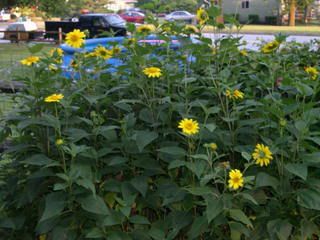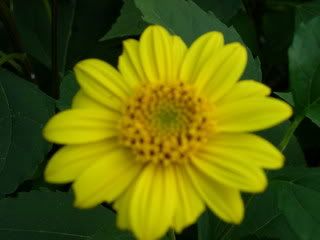Mystery Plant
Every year, towards the end of summer, I can't help but go to my favorite greenhouse just to see what bargains might be left for the taking. You never know when you might find something great that's been overlooked.
About five years ago, while perusing leftover annuals and perennials at Glick's Greenhouses in Oley, an odd-looking plant caught my eye. It had two stems about 5-ft. tall with large blooms resembling sunflowers. It was in the area of the perennials, and I thought how great would it be to have a perennial "sunflower." There was no tag, so I had no idea what this "mystery" plant actually was, other than perennial.
It cost $1.95, so I figured what the heck ... I took it home and found a spot near the corner of the garden pathway, between a butterfly bush and clematis. I couldn't wait till the next summer to see what it would do.
Well, it certainly didn't disappoint. The plant came up abundant the next year, much more dense than the two stems I had purchased it as. It grew at least 4-ft. tall and had fabulous sunflower-like yellow blooms from July-September. We absolutely loved it and referred to it as our "sunflower bush."

It continued to stay hardy and spread. I had to start digging it up each year, because it was spreading too much. I've given it to my mother, friends and coworkers and they've all had success. I've planted it all along our fence and it provides a beautiful screen.
I recently found it in a nursery while on vacation and, after learning its proper name (helianthus x multiflorus), looked it up on the Internet. Here's what I found.
It's common name is Capenoch Star, and it is actually considered a Perennial Sunflower. Who knew? It's clean, deep green leaves give way to large, single, bright yellow flowers that are reminiscent of annual sunflowers with their wide centers. Refreshing and attractive .. especially to butterflies and bees. It prefers moist soils in full sun, but is tolerant of drought and light shade. Fertilizer is recommended, but believe me, I've never had to do anything to propagate this plant. It may be divided or can be rooted thru cuttings.

The site warns that Helianthus can be quite invasive, which I've found to be true. And because of its height, it's best utilized in the back of a border garden to accent lower growing perennials.
So don't ever be afraid of buying that Mystery Plant. Sometimes you get a better bargain than you ever thought you would!
About five years ago, while perusing leftover annuals and perennials at Glick's Greenhouses in Oley, an odd-looking plant caught my eye. It had two stems about 5-ft. tall with large blooms resembling sunflowers. It was in the area of the perennials, and I thought how great would it be to have a perennial "sunflower." There was no tag, so I had no idea what this "mystery" plant actually was, other than perennial.
It cost $1.95, so I figured what the heck ... I took it home and found a spot near the corner of the garden pathway, between a butterfly bush and clematis. I couldn't wait till the next summer to see what it would do.
Well, it certainly didn't disappoint. The plant came up abundant the next year, much more dense than the two stems I had purchased it as. It grew at least 4-ft. tall and had fabulous sunflower-like yellow blooms from July-September. We absolutely loved it and referred to it as our "sunflower bush."

It continued to stay hardy and spread. I had to start digging it up each year, because it was spreading too much. I've given it to my mother, friends and coworkers and they've all had success. I've planted it all along our fence and it provides a beautiful screen.
I recently found it in a nursery while on vacation and, after learning its proper name (helianthus x multiflorus), looked it up on the Internet. Here's what I found.
It's common name is Capenoch Star, and it is actually considered a Perennial Sunflower. Who knew? It's clean, deep green leaves give way to large, single, bright yellow flowers that are reminiscent of annual sunflowers with their wide centers. Refreshing and attractive .. especially to butterflies and bees. It prefers moist soils in full sun, but is tolerant of drought and light shade. Fertilizer is recommended, but believe me, I've never had to do anything to propagate this plant. It may be divided or can be rooted thru cuttings.

The site warns that Helianthus can be quite invasive, which I've found to be true. And because of its height, it's best utilized in the back of a border garden to accent lower growing perennials.
So don't ever be afraid of buying that Mystery Plant. Sometimes you get a better bargain than you ever thought you would!
Labels: Capenoch Star, Glick's Greenhouses, helianthus x multiflorus, mystery plant, perennials, sunflowers
 RSS
RSS


